Appointment Reminder Templates That Actually Work
If what you send your patients doesn’t resonate with them, they’re still not likely to remember their upcoming appointment. Luckily, you can base your ideas off these appointment reminder templates.
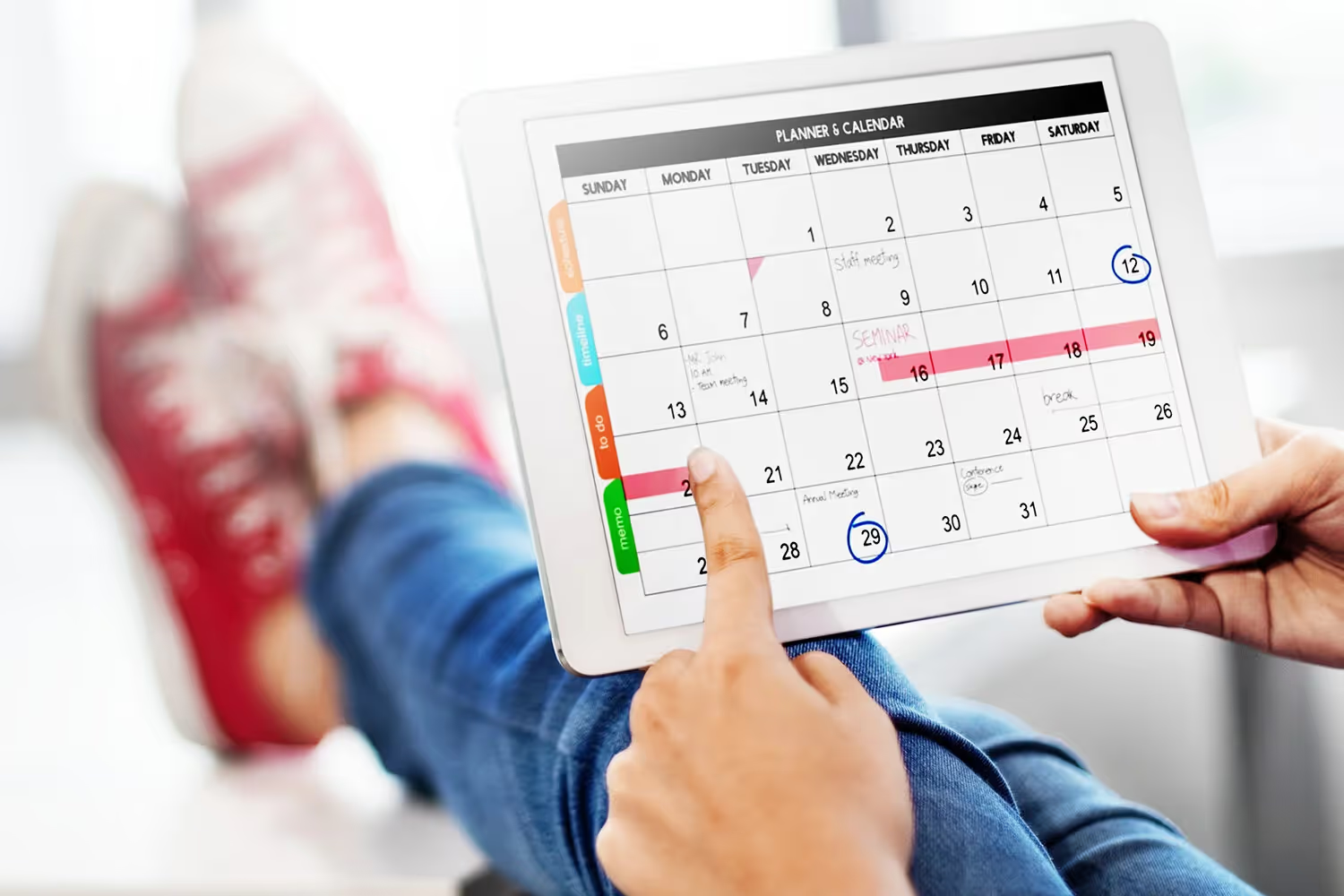
When it comes to getting patients into your office for appointments, you need to send them reminders. There’s no way around it.
If you don’t, they’ll be more likely to forget and you’ll have more no-shows. After all, practices that don’t send reminders have a no-show rate of over 10%.
Reminders benefit your practice if you use them correctly, but this takes some effort. Determining when to send them and which communication methods to use are only part of the challenge.

Once you narrow down those options, you have to actually make the content for your templates. The question is what to include so that your patients are most likely to make it in for their visit.
Well, there are a lot of directions you can take. Some messages are more important depending on the service your patient will receive. Or if it’s a new patient, certain reminders are more useful to send initially.
What you include in your reminders can help the message stick with the patient. If it doesn’t resonate with them, they’re still not likely to remember even if you did include the date and time of their visit.
Here are some helpful suggestions if you’re having trouble deciding how to make your templates. You don’t just say “Your appointment is on [date] at [time].” That won’t get anyone’s attention.
You can base your ideas off of these appointment reminder templates.
1. Thank You
It never hurts to show appreciation for your patients. After all, they’re why your practice exists.
When creating your appointment reminder templates, you should include one thanking your patients. This is as simple as thanking them for scheduling their next visit. You can also show appreciation for sticking to their appointment time or rescheduling early if they have to.
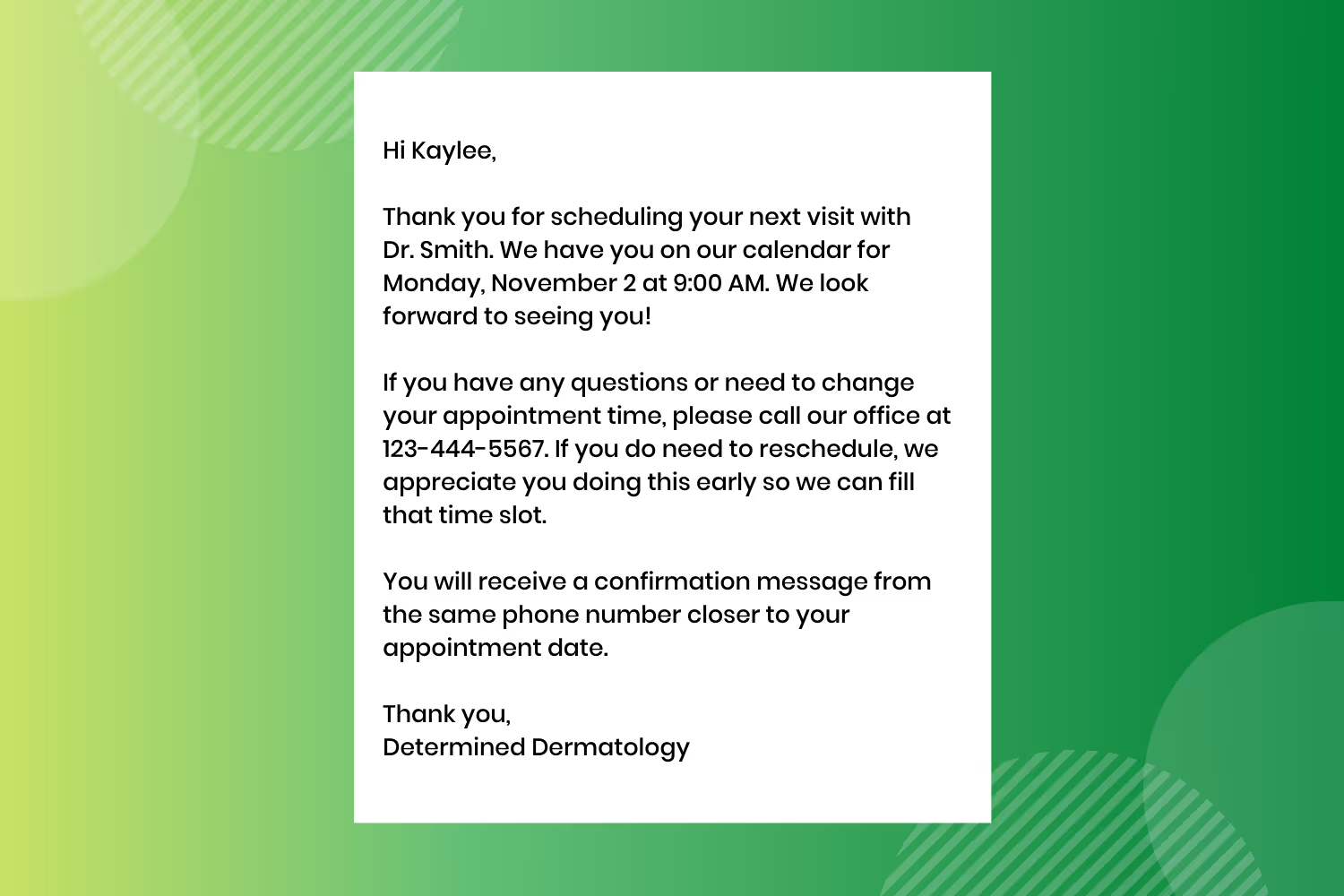
You can send these out right after they schedule their visit so they remember to add it to their calendar. Patients also forget a majority of information after they leave the doctor’s office. There’s a chance they won’t remember an appointment date if they didn’t already add it to their calendar.
But sending out an initial reminder thanking them for booking an appointment will encourage them to add it to their schedule. If you do send these messages well in advance, make sure you still send another reminder closer to the date. Mention in this first message that you’ll be sending a future confirmation. That way they’ll keep it on their radar so they’re more likely to respond since they’ll be expecting and watching for it.
2. Provide a Calendar
To simplify your reminders, add some form of a calendar. This enables your patients to directly add it to their schedules so they won’t forget.

You can do this in several different ways depending on which communication method you use.
For example, texting the date and time will give smartphone users the option to add it to their calendar on their device.
You can still send an invitation via email. This also allows clients to add it directly to their busy schedules. Or, you could link to a calendar where your practice keeps all open time slots. This makes it easy for patients to choose a new date and time in case they need to reschedule.
If you send a reminder via snail mail, include a small calendar printout that can hang on the fridge or bulletin board. You can even provide a sticker that they can add to a physical calendar or planner if they have one.

3. Include Confirmation
One of the most important parts to include within your appointment reminder templates is a confirmation action.
It’s helpful to send multiple reminders between the time of scheduling and the actual visit.
At least one of these should include a confirmation option. This should be a message closest to their visit but before your cancellation window goes into effect.

That way, there’s the smallest time frame for anything to come up that would cause the patient to need to change their confirmation status.
4. What to Bring
There are certain items you require your clients to bring with them such as proof of insurance or medications they’re currently prescribed.
Patients don’t always know if they need to bring these things, especially if they’ve been there before. They might not see a reason to bring these things every time they visit. But people can get anxious showing up empty-handed.
It’s helpful to inform recipients of your appointment reminders if there’s anything they need to bring and why it’s important. If they don’t need to bring anything, you can even tell them that just so they don’t feel nervous that they forgot something or aren’t prepared.
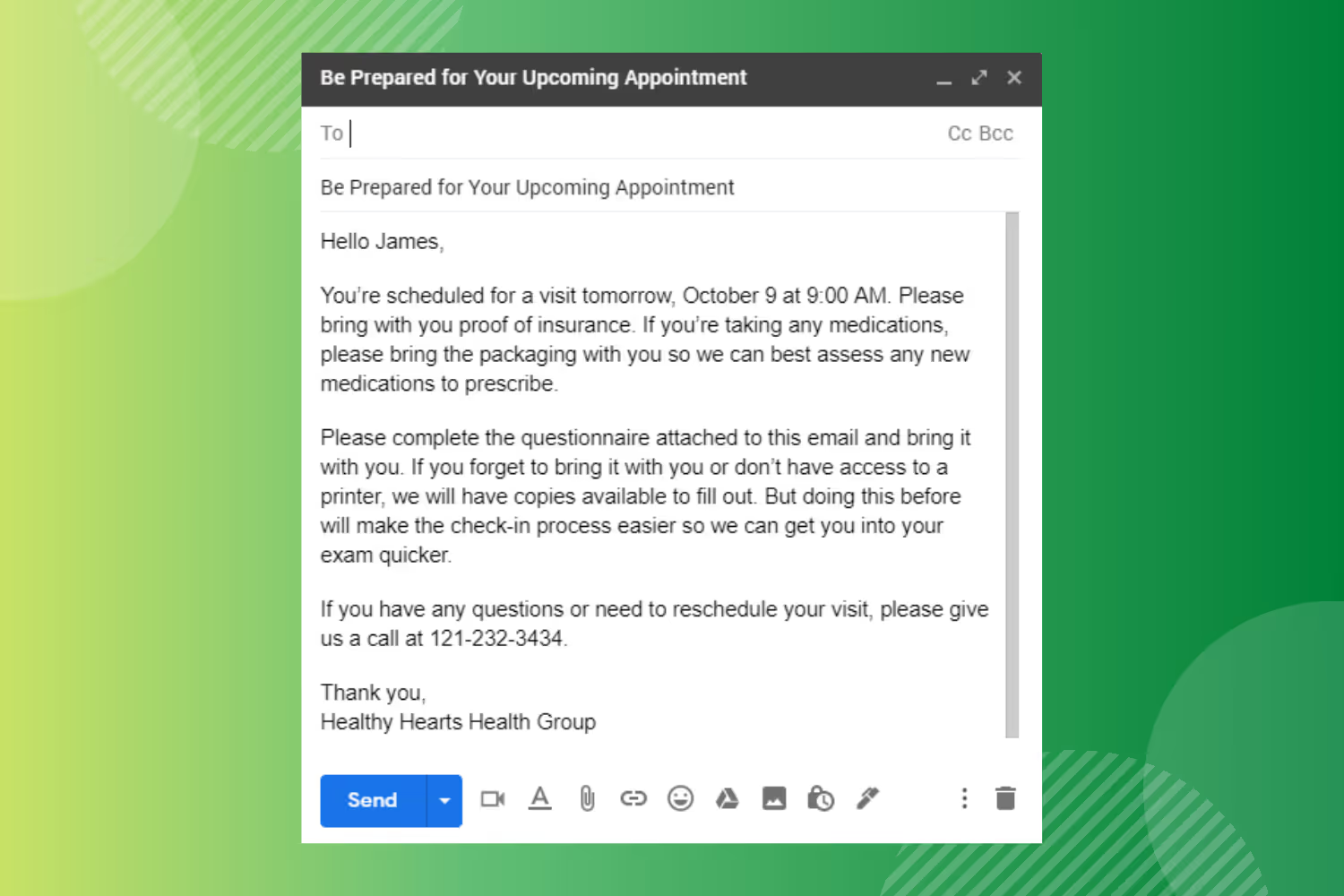
5. Dynamic Messages
Unsurprisingly, services will have different requirements. For example, a consultation about wisdom teeth is much more simple than actually having them removed.
Depending on the type of visit, you should use dynamic message templates. These are messages that change depending on the service the patient will receive. That way, they receive all of the information they should be aware of before setting foot in your office.
Appointments don’t just get canceled because someone didn’t show up. Sometimes your practice needs to cancel them even if the patient arrives but didn’t properly prepare.
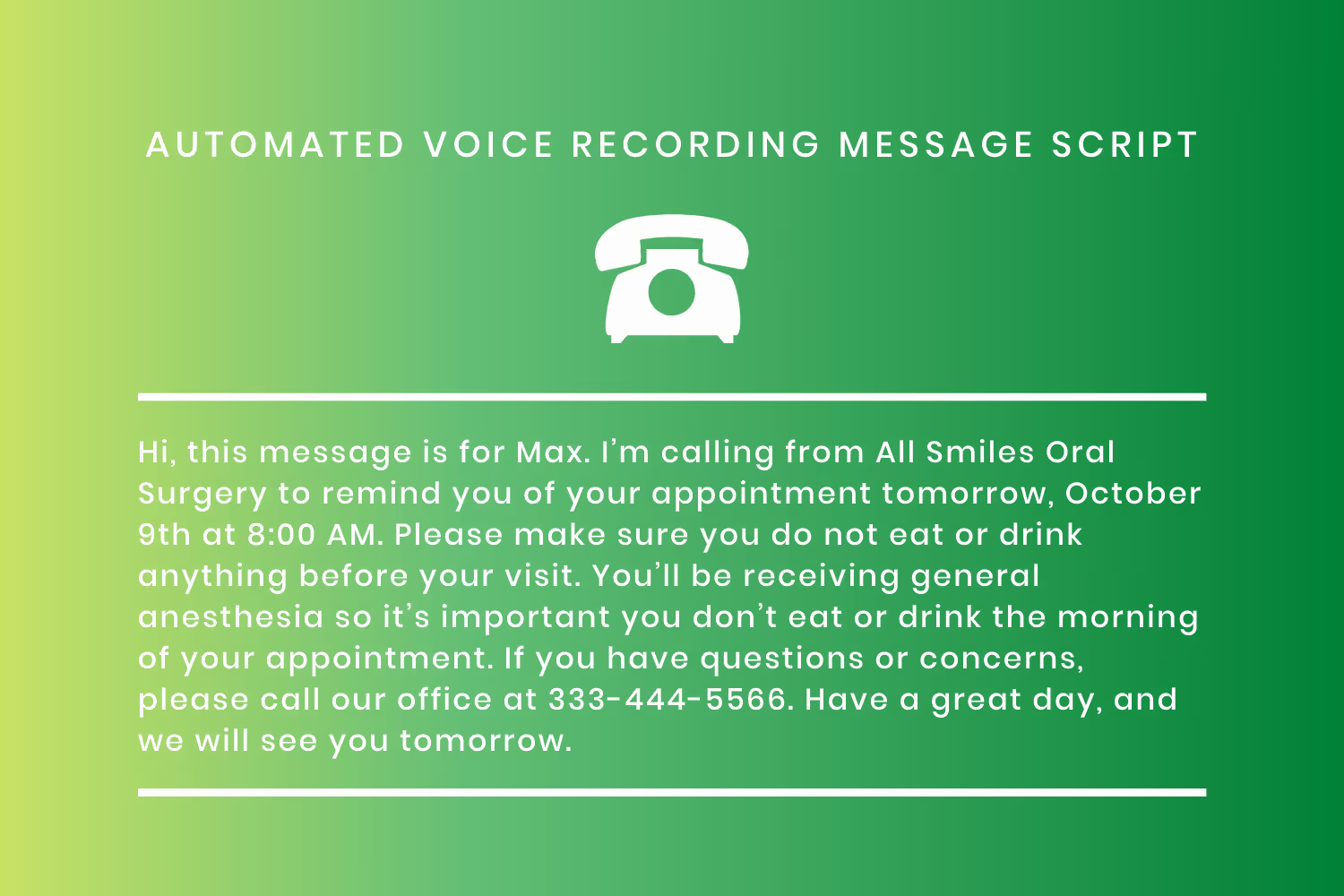
You should create messages depending on the service so that when you remind patients of their visit, you also inform them of how to prepare. This way, they can still receive their services when they show up and you don’t need to reschedule at the last minute.
6. Make It Light-Hearted
It’s no surprise that people get nervous about seeing the doctor. The anxiety of a visit is enough to make people avoid them, regardless of how much effort you put into making them feel welcomed.
Making some templates that are light-hearted or humorous will help patients relax. This characterizes your practice less as just a bearer of bad news. Instead, it helps patients relate to your staff through something positive beyond their bill of health.

7. Emphasize Your Address
One of the last things you want is for your patient to show up at the wrong location. This is an entirely preventable mistake that would cause a no-show or late arrival.
Think about all of the different healthcare professionals people visit. The average amount of doctors that a patient sees in their lifetime is almost 20. And those over 65 years old see ten more on top of that.
Those who take care of other family members, such as children or their parents, have even more doctors to keep up with. This could lead patients to mix up locations and drive to the wrong office.
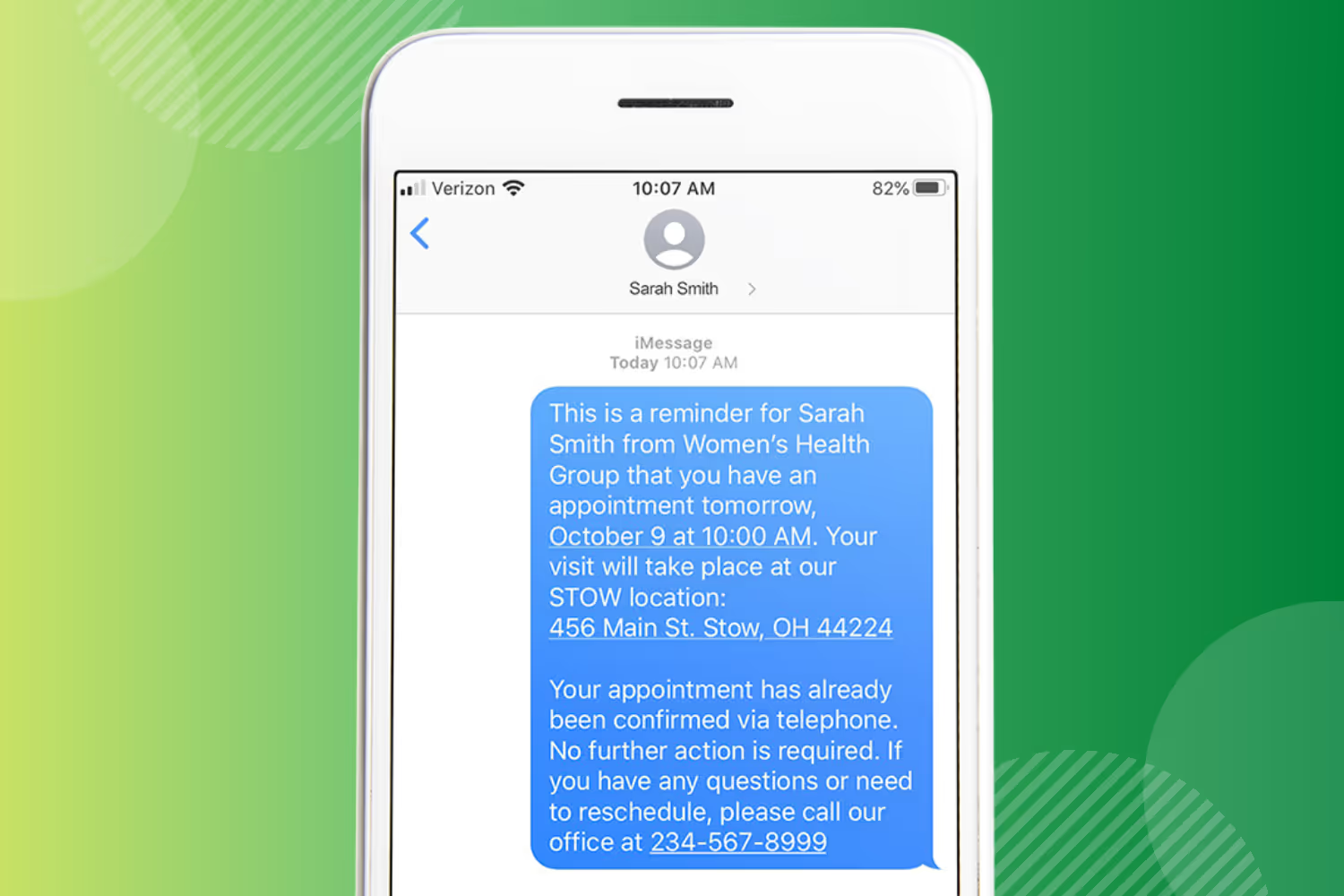
There’s even more confusion if your organization has multiple locations. Most people will just search for the address on Google. But, if you have more than one office then this could be different from where their visit is.
Because of this, you need to emphasize the address of where their appointment will take place. You can include it in your signature message of each reminder, but also state it within one of the messages so they don’t miss it.
8. Provide a Map
Besides just reiterating the address, include actual directions within your appointment reminder. If your practice is in a downtown city area, it can be easy to get lost especially if finding somewhere to park is a challenge.
Not only is it useful to link to a map, but you can include specific directions based on common ways that people approach your office. This makes it more clear to find in terms of their surroundings rather than the generic instructions from an automated GPS.

Patients might also get lost while trying to navigate the halls of your building. Of course, this is more specific to larger practices.
But, have you ever been leaving an exam room of a small office and realize you don’t remember which way you came from? It happens to the best of us.
Regardless of the size of your office, someone can get lost if they haven’t been there enough. This is why you can also provide a map of the patient’s visit. Include where they’ll park, which entrance to use, how to get to the check-in desk and how to get to their exam room.
Giving clear directions reduces frustration, especially for those running late so they don’t waste time trying to figure out where to go.
9. Emphasize Importance
Some people might not think it’s a big deal if they end up needing to miss their appointment. But most visits have timely importance.
This could be because it’s at a busy time of the year when it’s hard to get anything scheduled. Or treatment for their condition might be more pressing than they understand.
If you reiterate how important it is that they come in for their visit, they’ll be more likely to remember. After all, they don’t want to deal with more health complications.
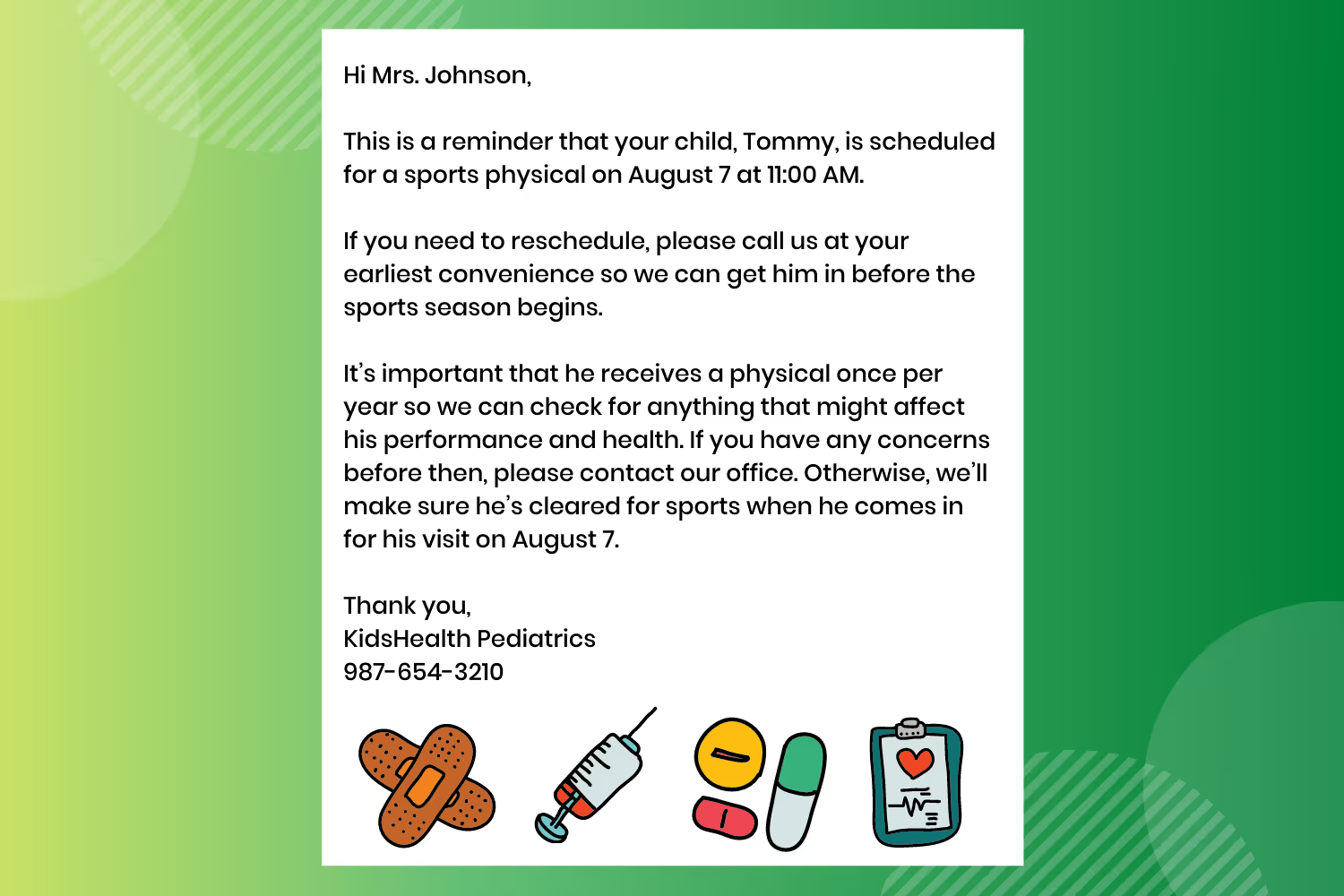
And if they know it’s a challenge to switch their scheduled appointment, they’ll prioritize their visit time so they don’t need to deal with any hassle.
10. Reiterate Your Cancellation Policy
While you should always mention that your patients should contact you if they need to reschedule, you need to let them know why they need to do this.
Most practices have a cancellation policy.

If you don’t, you should develop one because they help reduce no-shows. But not many clients know what a cancellation policy is. Maybe you informed them when they first became patients, but at this point, they likely forgot.
Even up until the last day, patients could call and reschedule. But they’re less likely to switch their time if they know that they could get penalized for it. Include in your reminders what’s at stake if they cancel too late or don’t arrive on time. This will get them to prioritize their visit time because they don’t want an unnecessary fee or face a long wait time.
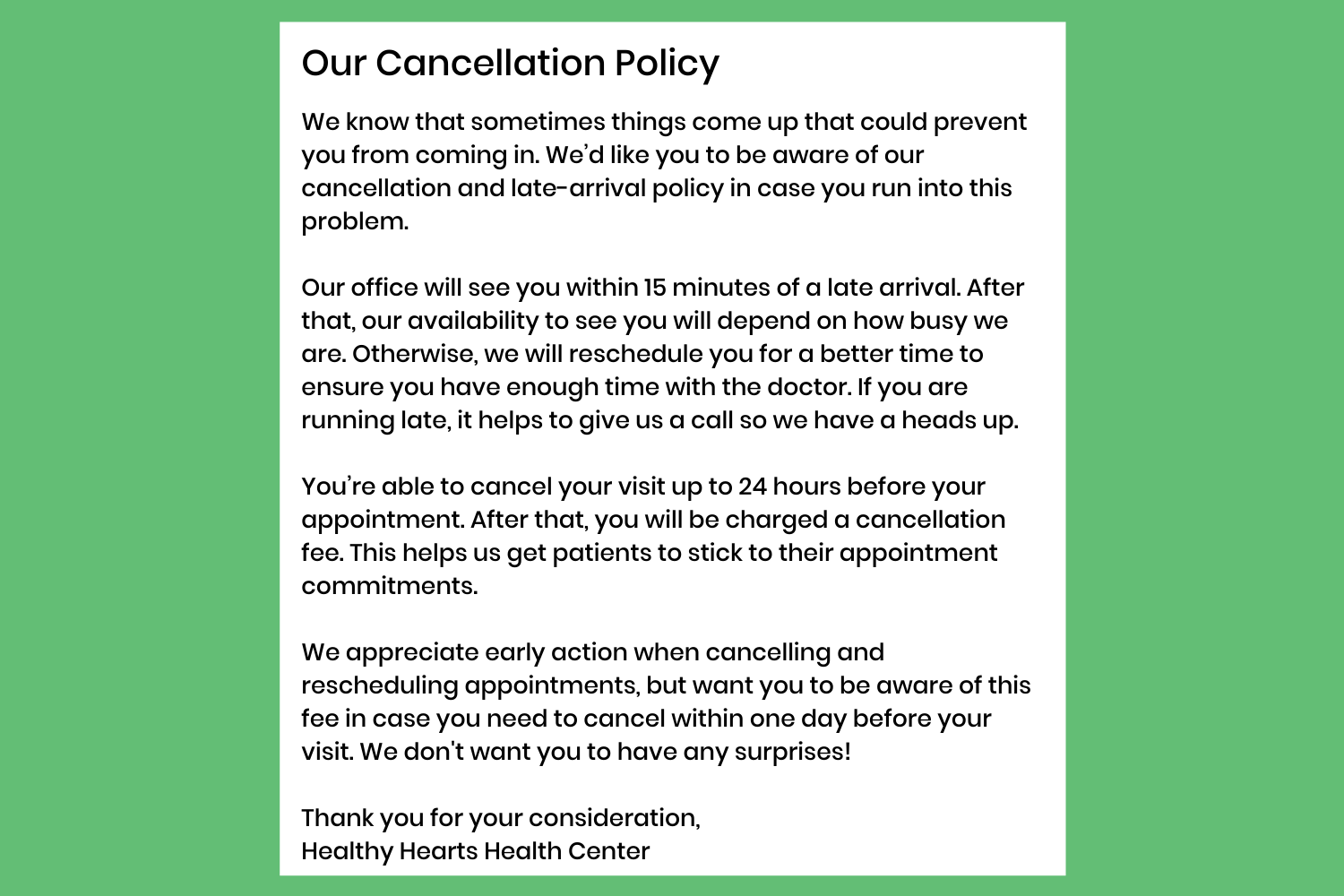
11. Add Reminder Preferences
Finally, one of your templates should allow them to change their communication method preference. You may be using multiple methods to maximize the chance that they’ll see their reminders. But they might hardly use some of those channels.
Confirm which method they prefer, that way you can primarily send reminders through that channel. Then they’ll be more likely to see your messages and are less likely to forget or miss a visit.
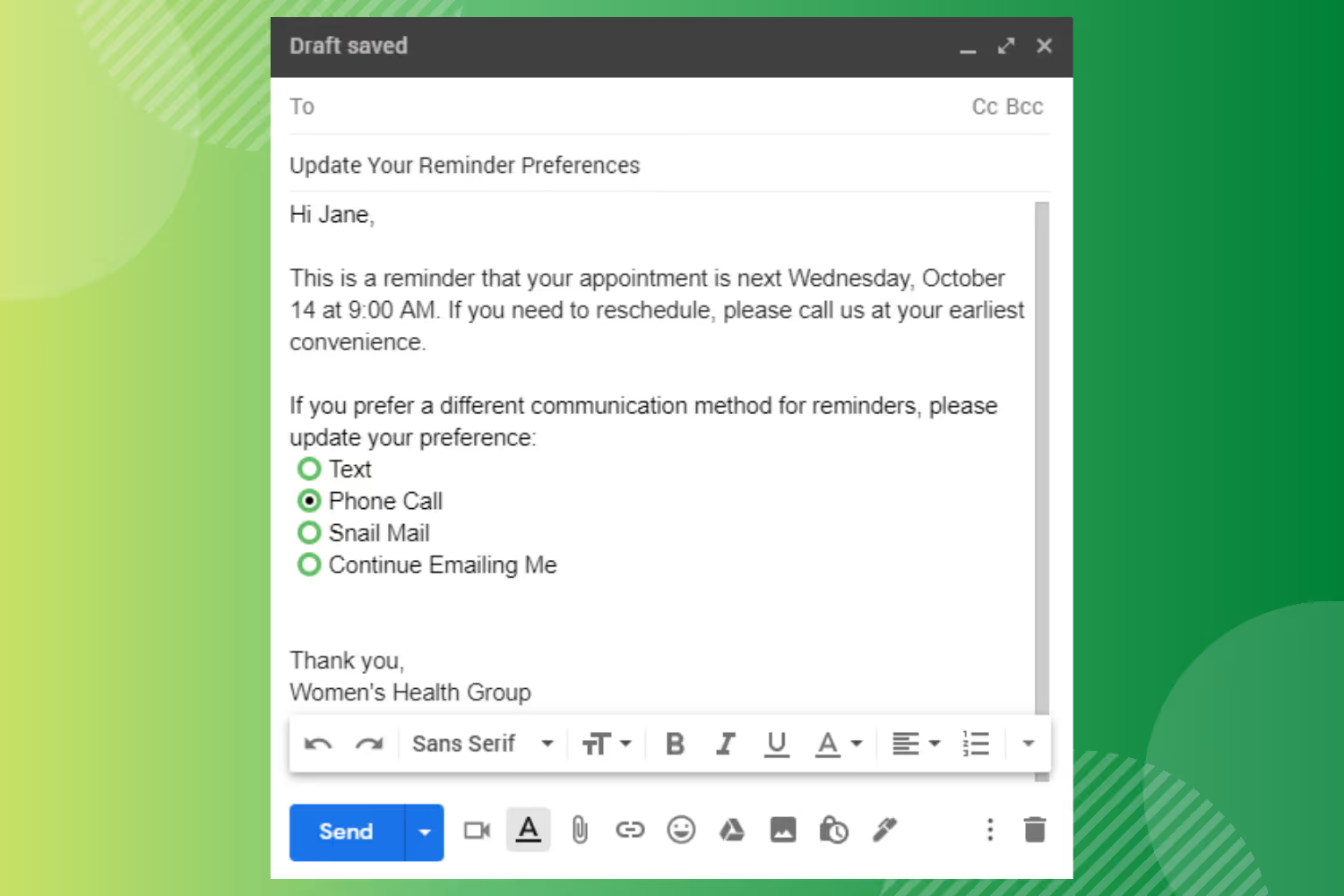
Conclusion
The messages you send to your patients reminding them about their forthcoming appointment are important.
Sure, you need to come up with a consistent schedule and effective communication methods.
But the content is the most challenging part. If it doesn’t land with your patients, they’re still likely to forget about their visit.
It isn’t always about just telling your patient the date and time of their visit. There are other details they need for showing up on time and prepared. You can take these messages in so many directions depending on what the patient needs to remember most for their visit.
Once you decide what is most necessary for them to know, you can develop a series of appointment reminder templates. You can use these suggestions for ideas, or switch out details for your information. This is a good starting point for determining what is most effective for getting patients to remember their appointments.
Emphasize your product's unique features or benefits to differentiate it from competitors
In nec dictum adipiscing pharetra enim etiam scelerisque dolor purus ipsum egestas cursus vulputate arcu egestas ut eu sed mollis consectetur mattis pharetra curabitur et maecenas in mattis fames consectetur ipsum quis risus mauris aliquam ornare nisl purus at ipsum nulla accumsan consectetur vestibulum suspendisse aliquam condimentum scelerisque lacinia pellentesque vestibulum condimentum turpis ligula pharetra dictum sapien facilisis sapien at sagittis et cursus congue.
- Pharetra curabitur et maecenas in mattis fames consectetur ipsum quis risus.
- Justo urna nisi auctor consequat consectetur dolor lectus blandit.
- Eget egestas volutpat lacinia vestibulum vitae mattis hendrerit.
- Ornare elit odio tellus orci bibendum dictum id sem congue enim amet diam.
Incorporate statistics or specific numbers to highlight the effectiveness or popularity of your offering
Convallis pellentesque ullamcorper sapien sed tristique fermentum proin amet quam tincidunt feugiat vitae neque quisque odio ut pellentesque ac mauris eget lectus. Pretium arcu turpis lacus sapien sit at eu sapien duis magna nunc nibh nam non ut nibh ultrices ultrices elementum egestas enim nisl sed cursus pellentesque sit dignissim enim euismod sit et convallis sed pelis viverra quam at nisl sit pharetra enim nisl nec vestibulum posuere in volutpat sed blandit neque risus.

Use time-sensitive language to encourage immediate action, such as "Limited Time Offer
Feugiat vitae neque quisque odio ut pellentesque ac mauris eget lectus. Pretium arcu turpis lacus sapien sit at eu sapien duis magna nunc nibh nam non ut nibh ultrices ultrices elementum egestas enim nisl sed cursus pellentesque sit dignissim enim euismod sit et convallis sed pelis viverra quam at nisl sit pharetra enim nisl nec vestibulum posuere in volutpat sed blandit neque risus.
- Pharetra curabitur et maecenas in mattis fames consectetur ipsum quis risus.
- Justo urna nisi auctor consequat consectetur dolor lectus blandit.
- Eget egestas volutpat lacinia vestibulum vitae mattis hendrerit.
- Ornare elit odio tellus orci bibendum dictum id sem congue enim amet diam.
Address customer pain points directly by showing how your product solves their problems
Feugiat vitae neque quisque odio ut pellentesque ac mauris eget lectus. Pretium arcu turpis lacus sapien sit at eu sapien duis magna nunc nibh nam non ut nibh ultrices ultrices elementum egestas enim nisl sed cursus pellentesque sit dignissim enim euismod sit et convallis sed pelis viverra quam at nisl sit pharetra enim nisl nec vestibulum posuere in volutpat sed blandit neque risus.
Vel etiam vel amet aenean eget in habitasse nunc duis tellus sem turpis risus aliquam ac volutpat tellus eu faucibus ullamcorper.
Tailor titles to your ideal customer segment using phrases like "Designed for Busy Professionals
Sed pretium id nibh id sit felis vitae volutpat volutpat adipiscing at sodales neque lectus mi phasellus commodo at elit suspendisse ornare faucibus lectus purus viverra in nec aliquet commodo et sed sed nisi tempor mi pellentesque arcu viverra pretium duis enim vulputate dignissim etiam ultrices vitae neque urna proin nibh diam turpis augue lacus.


.avif)

